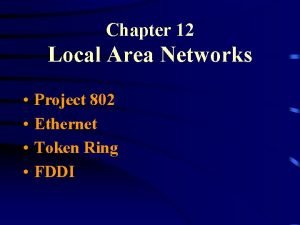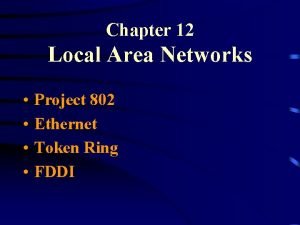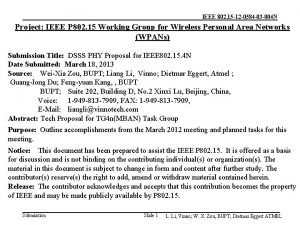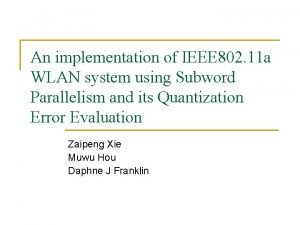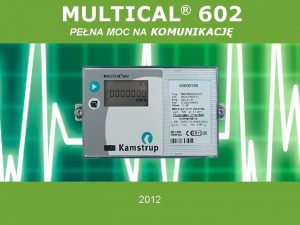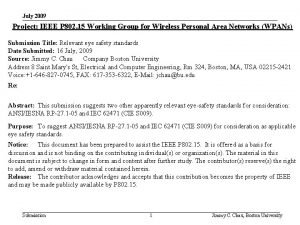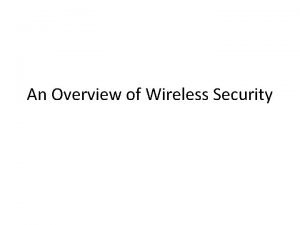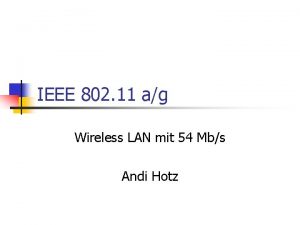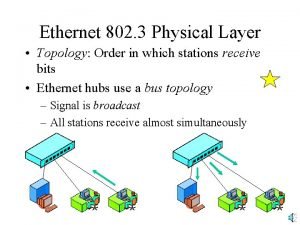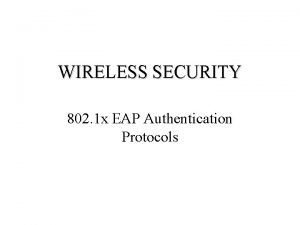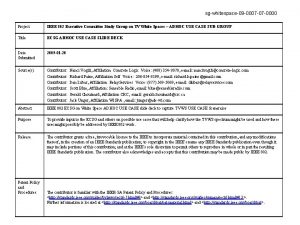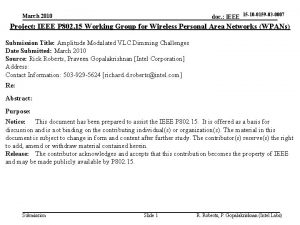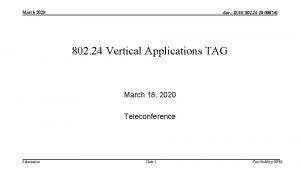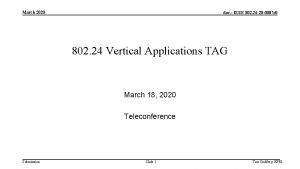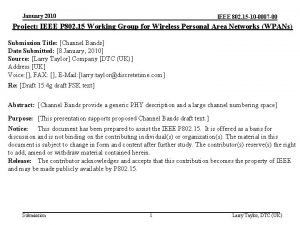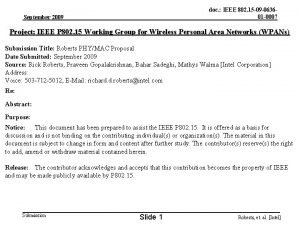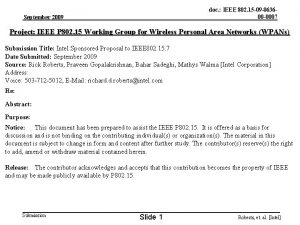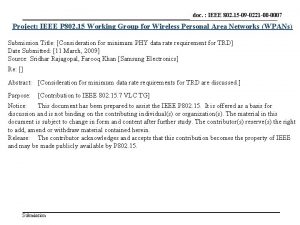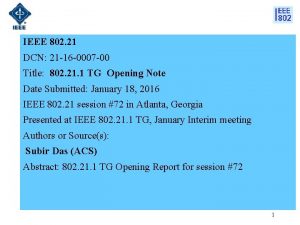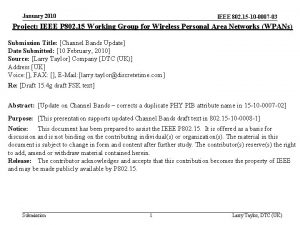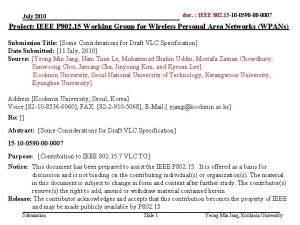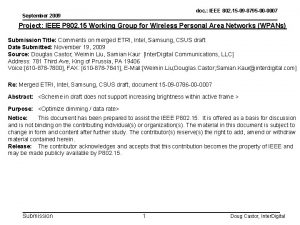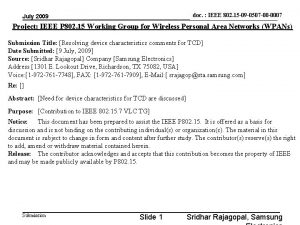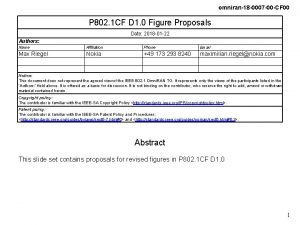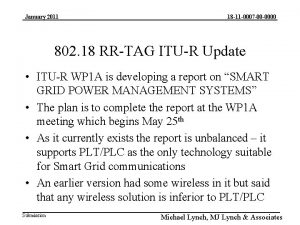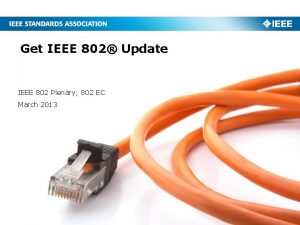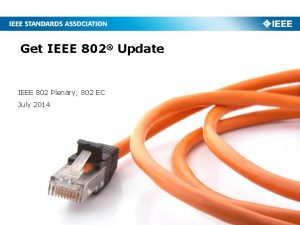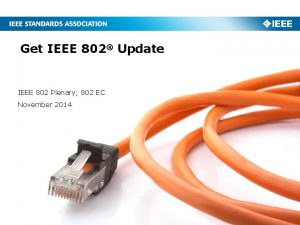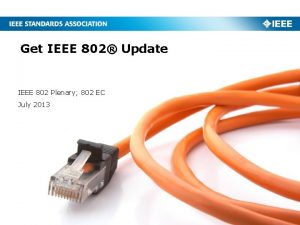IEEE 802 15 10 0007 04 Project IEEE

























- Slides: 25

IEEE 802. 15 -10 -0007 -04 Project: IEEE P 802. 15 Working Group for Wireless Personal Area Networks (WPANs) Submission Title: [Channel Bands Update] Date Submitted: [10 February, 2010] Source: [Larry Taylor] Company [DTC (UK)] Address [UK] Voice: [], FAX: [], E-Mail: [larry. taylor@discretetime. com] Re: [Draft 15. 4 g draft FSK text] Abstract: [Update on Channel Bands – corrects a duplicate PHY PIB attribute name in 15 -10 -0007 -02] Purpose: [This presentation supports updated Channel Bands draft text in 802. 15 -10 -0008 -1] Notice: This document has been prepared to assist the IEEE P 802. 15. It is offered as a basis for discussion and is not binding on the contributing individual(s) or organization(s). The material in this document is subject to change in form and content after further study. The contributor(s) reserve(s) the right to add, amend or withdraw material contained herein. Release: The contributor acknowledges and accepts that this contribution becomes the property of IEEE and may be made publicly available by P 802. 15. Submission 1

IEEE 802. 15 -10 -0007 -04 Channel Bands Update Separate Standard Channel Page & Generic PHY Channel Page structures Submission 2

IEEE 802. 15 -10 -0007 -04 Focus of the Update • The general form of the Channel Band Descriptor provides a very powerful generic PHY description mechanism • However, the Standard PHYs don’t need the general form of the descriptor • This update separates the standard channel page description (Channel Page 7) from the Generic PHY description (Channel Page 8) and defines a channel numbering scheme for standard 15. 4 g operation Submission 3

IEEE 802. 15 -10 -0007 -04 Part I – Standard Operation Channel Numbering Submission 4

IEEE 802. 15 -10 -0007 -04 Reminder – The Problem • 15. 4 g defines – A large number of frequency bands (~20) – A large number of PHY Modes (~50) • Different data rates, channel separation, modulation – Any PHY Mode may operate over a frequency band • Not all combinations are defined, but in general all are possible – This results in a very large number of distinct channels – far more than can be represented using the 32 -bit Channel Page/Channel Number structure Submission 5

IEEE 802. 15 -10 -0007 -04 Existing Constraints • Many MAC Management primitives and MAC Commands use Channel Page and Channel Number parameters • To maintain consistency with existing 15. 4 specifications the extended channel numbering model must retain Channel Page and Channel Number structure • In addition, the MLME-SCAN primitive has an explicit Scan. Channels parameter defined as a 27 -bit field – Needs re-definition for 15. 4 g – Field size is PHY Mode & frequency band dependent Submission 6

IEEE 802. 15 -10 -0007 -04 15. 4 g Channel Page 7 Structure • Define Channel Page 7 for 15. 4 g • Bit positions index into the table of standard frequency bands • A device sets the corresponding bit to 1 for each standard frequency band supported • It is a convenient way of avoiding defining a PHY PIB attribute phy. Frequency. Bands. Supported Submission 7

IEEE 802. 15 -10 -0007 -04 Page 7 Bit Index • Each bit position in Page 7 corresponds to an index in the Standard Frequency Band Table • Bit 20. . 27 are unused and reserved for future use Submission 8

IEEE 802. 15 -10 -0007 -04 Current Frequency Band • Add a PHY PIB attribute phy. Current. Frequency. Band • Value is an index into the standard frequency band table • Must correspond to a bit set to 1 in Channel Page 7 bits 0. . 26 • Identifies which of the supported standard frequency bands is currently being used Submission 9

IEEE 802. 15 -10 -0007 -04 PHY Mode • Add a PHY PIB attribute phy. PHYModes. Supported – A bit mask of supported PHY Modes (bit set to 1) with each bit corresponding to an index into the table of standard PHY Modes – Size is determined by the number of standard PHY Modes • Add PHY PIB attribute phy. Current. PHYMode • Its value is an index into the table of standard PHY Modes and must correspond to a bit set to 1 in phy. PHYModes. Supported Submission 10

IEEE 802. 15 -10 -0007 -04 Channels Supported • The current 15. 4 channel bit mask in bits 0. . 26 of the Channel Page indicate which channels are supported • Allows a subset of possible channels to be supported • Also used for channel scanning • Add a PHY PIB attribute phy. Current. Channels. Supported to hold the channel bit mask for the current frequency band • Size is frequency band PHY Mode dependent Submission 11

IEEE 802. 15 -10 -0007 -04 Number of Channels • Add a PHY PIB attribute phy. Number. Channels • Identifies the number of channels for phy. Current. PHYMode in phy. Current. Frequency. Band • Also identifies the number of significant bits in phy. Channels. Supported Submission 12

IEEE 802. 15 -10 -0007 -04 Current Channel • The current channel is therefore determined by: – phy. Current. Channel • A number in the range 0. . phy. Number. Channels-1 • Corresponding bit position in phy. Current. Channels. Supported must be set to 1 – phy. Current. Frequency. Band • A bit position in Page 7 set to 1 • Indexes table of standard frequency bands – phy. Current. PHYMode • An index into the table of standard PHY Modes Submission 13

IEEE 802. 15 -10 -0007 -04 Standard Canonical Name • To support negotiation of mode of operation by higher layers – Index values of standard frequency bands and PHY Modes – Channel number is qualified by • standard frequency band phy. Current. Frequency. Band • PHY Mode phy. Current. PHYMode • Channels supported phy. Channels. Supported Submission 14

IEEE 802. 15 -10 -0007 -04 PHY PIB Attributes • New PHY PIB Attributes • phy. Current. Frequency. Band • • phy. PHYModes. Supported • • Value is the number of channels in phy. Current. Frequency. Band for phy. Current. PHYMode phy. Current. Channels. Supported • • Value is an index into the table of standard PHY Modes and must correspond to a bit set to 1 in phy. PHYModes. Supported phy. Number. Channels • • Bit mask of PHY Modes supported. Each bit corresponds to an index into the standard table of PHY Modes phy. Current. PHYMode • • Value is an index into the table of standard frequency bands and must correspond to a bit position in Channel Page 7 set to 1 Channel bit mask of size phy. Number. Channels identifying which channels may be used in the current freqency band Modified PHY PIB Attributes • phy. Current. Channel • • Submission Requires amended definition since range will be >27 for some SUN frequency bands and is frequency band PHY Mode dependent phy. Current. Channel must correspond to a bit position in phy. Current. Channels. Supported set to 1 15

IEEE 802. 15 -10 -0007 -04 Part II – Generic PHY The Channel Band Descriptor Submission 16

IEEE 802. 15 -10 -0007 -04 The Problem • To allow 15. 4 g compliant systems to declare vendor specific modes of operation in a standard way • Permit exchange and negotiation of operating parameters (frequency band PHY Mode) • Provide efficient short canonical name suitable for use in commands Submission 17

IEEE 802. 15 -10 -0007 -04 15. 4 g Channel Page 8 Structure • Define Channel Page 8 for 15. 4 g • Each bit 0. . 26 (set to 1) identifies a Generic PHY descriptor Submission 18

IEEE 802. 15 -10 -0007 -04 Generic PHY Descriptor • Generic PHY Descriptors are only in Channel Page 8 • Page 8 + ID forms a canonical name • Frequency descriptor part based on band agnostic representation • Parametric PHY part is PHY Type dependent – Parameters for FSK PHY are suggested Submission 19

IEEE 802. 15 -10 -0007 -04 PHY PIB Attributes • Add PHY PIB attribute phy. Number. Generic. PHYDescriptors • Add PHY PIB attribute phy. Generic. PHYDescriptors – Array of phy. Number. Generic. PHYDescriptors elements each one containing a Generic PHY Descriptor – Elements are uniquely identified by ID in the local system • Add PHY PIB attribute phy. Current. Generic. PHYDescriptor – Value is the ID of a Generic PHY Descriptor and must correspond to a bit set to 1 in bits 0. . 26 of Channel Page 8 Submission 20

IEEE 802. 15 -10 -0007 -04 Part III – Mode Switch Support Submission 21

IEEE 802. 15 -10 -0007 -04 Mode Switch PPDU • Flag in the PHY Header identifies a frame PPDU variant for Mode Switching • The Frame needs a parameter to identify the operating mode of the subsequent PPDU • The canonical name serves as this parameter Submission 22

IEEE 802. 15 -10 -0007 -04 Canonical Name (1) • The canonical name is made up of two parts – Frequency Band part – PHY Mode part • Channel Page 7 – Frequency Band part is the bit index in channel page 7 and is the value of phy. Current. Frequency. Band – PHY Mode is the value of phy. Current. PHYMode and is an index into the PHY Mode table • Channel Page 8 – phy. Currrent. Generic. PHYDescriptor holds the ID of a generic PHY descriptor – Both Frequency Band & PHY Mode are identified in the generic PHY descriptor Submission 23

IEEE 802. 15 -10 -0007 -04 Canonical Name (2) • The canonical name is therefore – Channel Page (7) : Frequency Band Index : PHY Mode index – Channel Page (8) : Generic PHY Descriptor ID – An encoding in 16 bits (or less) is possible • The Mode Switch also needs a target Channel Number field Submission 24

IEEE 802. 15 -10 -0007 -04 Questions Submission 25
 Bridges from 802.x to 802.y
Bridges from 802.x to 802.y Bridges from 802.x to 802.y
Bridges from 802.x to 802.y Estandar ieee 802
Estandar ieee 802 802 ieee
802 ieee Ieee 802 family
Ieee 802 family Ieee802.22
Ieee802.22 Ieee 802 standard
Ieee 802 standard Ieee 802
Ieee 802 Ieee 802 3 compliance
Ieee 802 3 compliance Arquitetura ieee 802
Arquitetura ieee 802 Ieee 802 bluetooth
Ieee 802 bluetooth Logistics product data
Logistics product data Agent 0007
Agent 0007 Project 802
Project 802 Project 802
Project 802 Mac address
Mac address 802 15
802 15 Wlan 802
Wlan 802 Geo 802
Geo 802 Komunikacj
Komunikacj 09 802 0561
09 802 0561 802-11-wireless-security
802-11-wireless-security 802 5
802 5 Wireless lan 802
Wireless lan 802 802 3
802 3 802 eap
802 eap













